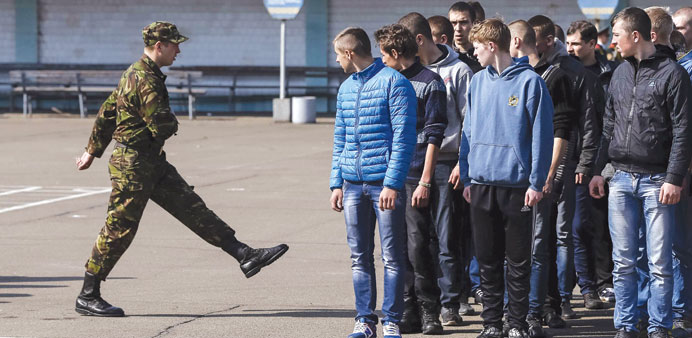Ukrainian conscripts lining up during a ceremony at the parade square of an army recruitment office in Kiev. Ukraine’s fight against Russia is a defence of core European values – and, indeed, of Europe itself.
By Anders Aslund/Washington
Ukraine may not be grabbing as many headlines now as it did a year ago, but the crisis there is far from over. The latest ceasefire agreement, concluded in Minsk in February, has contained, but not stopped, Russian military aggression.
And, though the stabilisation programme that Ukraine agreed with the International Monetary Fund (IMF) last month is superior to last year’s deal – this one includes both more financing from the IMF and a more credible economic-reform plan from the government – it will be insufficient to repair the country’s economy.
What Ukraine really needs is to escape the old Soviet order – and, for that, it needs the West’s help.
Ukraine never managed to recast its state after the Soviet Union’s collapse. Instead, the old Soviet elites held onto power – and most of the country’s wealth – through corrupt practices that became entrenched in the country’s economy and political system.
Reforming both will be a major challenge – one that Ukraine’s leaders have lately committed themselves to meeting.
Since February of last year, when the parliament voted then-president Viktor Yanukovych out of power by more than a two-thirds majority, Ukraine has held fresh elections for both institutions.
Hundreds of top officials have been replaced by young, Western-educated professionals, and the government is now working feverishly to implement deep and comprehensive reforms, including a new law on public procurement and a package of anti-corruption legislation.
Dozens of superfluous inspection agencies have been abolished, significantly reducing the regulatory burden. Just last month, President Petro Poroshenko sacked the governor of the Dnipropetrovsk region, the billionaire tycoon Igor Kolomoisky.
More recently, the authorities have been working to reform the energy sector – a hub of corruption. On April 1, household gas prices were quadrupled, taking them to half the market price, with offsetting compensation provided to the poor.
And the parliament has enacted a law that harmonises energy standards with those of the European Union, thereby delineating clearly the state’s role and opening the gas market to investors.
But Ukraine still has a long way to go. The good news is that the public largely understands and supports the government’s reform efforts. The bad news is that Ukraine still faces considerable destabilising threats – beginning with a renewed Russian military offensive.
A Russian attack on, say, Mariupol, eastern Ukraine’s second-largest port (accounting for roughly one-third of the country’s exports), would devastate an economy that is already tanking. Though several factors – including Western sanctions, a lack of public support for war in Ukraine, and the Russian economy’s rapid decline – should discourage the Kremlin from taking such a step, they may not be enough.
After all, Russia’s leaders have shown themselves to be unpredictable.
Even absent further Russian aggression, Ukraine’s economic woes could prevent further progress on reform. The economy contracted by 6.8% year on year in 2014, and output has plunged by 15% in each of the two last quarters.
Moreover, at the end of February, with the country running low on reserves, Ukraine’s currency, the hryvnia, lost half its value; as a result, annualised inflation surged to 45% in March. A full-scale financial meltdown was avoided only when the IMF provided an early disbursement that doubled Ukraine’s reserves, to $9.9bn; by the end of the month, the exchange rate more or less recovered.
Nonetheless, the international financing that Ukraine has received, though invaluable, remains insufficient to support genuine recovery and reform.
The latest bailout programme foresees about $40bn in funding, nearly half of which will come from the IMF, over the next four years. That means that, this year, Ukraine will receive only $10bn – not enough to enable the country to replenish its reserves and service its debts.
Indeed, given Ukraine’s large bond debts, many of which will mature in the next two years, there is a $15.3bn funding gap in the bailout package, which the IMF and Ukraine’s government hope to plug with a debt restructuring. But, even if they succeed, Ukraine would need more funding than it is getting.
It needs more strategic support as well. European politicians’ overwhelming opposition to supplying Ukraine with defensive arms is difficult to fathom. Europe’s leaders claim that they want to avoid giving Russia reason to escalate its war on Ukraine.
But that is already happening, and Ukraine’s fight against Russia is, after all, a defence of core European values – and, indeed, of Europe itself. The EU flag has draped the caskets of Ukrainians killed in that fight.
Europe’s leaders argue that the central focus of their policy toward Ukraine must be to support its economic recovery. But here, too, Europe is doing too little, offering paltry credits of €1.8bn ($1.9bn) this year, when €10bn would be more appropriate. If the US then met Europe halfway (at least), Ukraine’s financial crisis could finally be contained.
On April 28, Ukraine’s government will host a donor conference in Kiev. At a time when the country’s leaders and public are more committed than ever to combating corruption, building a welfare-creating economy, and becoming a normal liberal democracy, Europe should be eager to support it. It is time for Western politicians to remember their ideals – and stand up for them.-Project Syndicate
♦ Anders Aslund, a senior fellow at the Petersen Institute, is the author of Ukraine: What Went Wrong and How to Fix It.



